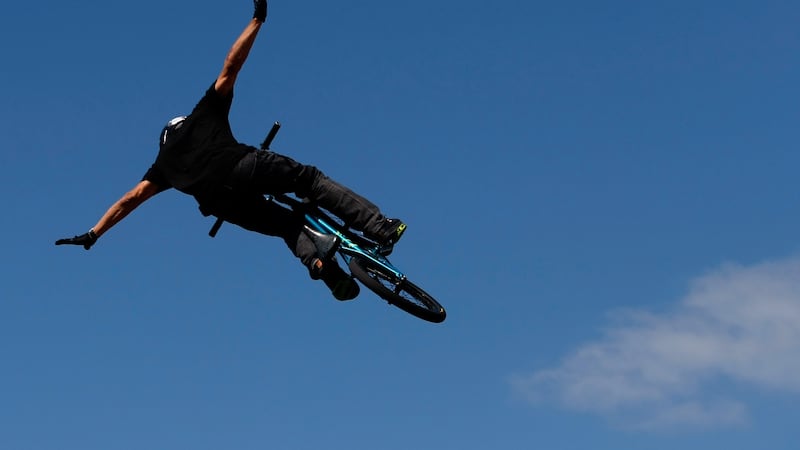The circumstances of his death did not become him. Dave Mirra made his name carving through air on a BMX bicycle that often appeared to be a two-wheeled extension of his own lithe frame. He spent more than 20 years inscribing gravity-defying parabolas, risking serious injury every time he ran through a panoply of spectacular tricks that came to define a sport's journey from the margins to the mainstream. Yet, he died sitting in the front of his pick-up truck in the driveway of a friend's house, from a single, self-inflicted gunshot wound to the head. At 41.
That Mirra’s passing last week was mourned far beyond the sport he once bestrode illustrates the outsized role he played as a pioneer of the X-Games, that thriving counter-culture for kids who prefer wheels to balls, measuring out their lives in the difficulty of tricks attempted rather than on plain, old scoreboards.
In a demi-monde with a dialect all its own, from barrel rolls to bunny hops, flatspins to footjam nosepicks, Mirra invented, amongst others, the Air Traffic Controller. A rather staid name for an audacious manoeuvre involving hurtling off a ramp at top-speed and doing a no-handed 360 degree backflip in mid-air before somehow returning gracefully to earth.

Once the most decorated athlete in X Games history, Mirra unfurled groundbreaking moves that inspired a generation of copycats to scuttle up and down ramps themselves. He garnered 14 gold medals, earned a raft of lucrative endorsement deals, including shoes and bubble gum that bore his name, and, for a time, hosted a reality show on MTV. He also boasted an eponymous video game, arguably the most telling benchmark of any sportsperson’s impact in the 21st century.
Along the way, the man nicknamed ‘Miracle Boy’ attained a type of recognition that would have been unimaginable when, at just 13, he caught the eye of Mat Hoffman, another pioneer in the sport.
Back then, kids tooling around on bikes were regarded as slackers rather than potential icons. These days, trying to decide whether Hoffman or Mirra was the greatest is the BMX equivalent of the interminable Messi-Ronaldo debate.
Like the punk band that goes from playing sweaty cellars to packing stadiums though, cashing in on his celebrity and the burgeoning popularity of extreme sports came freighted with criticism. This is a community where the simple aesthetic of nailing a trick or pulling off a stunt is regarded as more important than any bauble or accolade.
Sour grapes
“I think it’s sour grapes,” said Mirra of accusations he sold out. “They’re not happy, it’s their problem. I’m happy doing what I love to do. I think a lot of those guys haven’t even ridden half as long as I have. They can say whatever they want about me ’cuz it ain’t gonna hurt me, you know?”
Born in upstate New York, Mirra settled in Greenville, North Carolina, his mere presence there turning the place into such a focal point for BMX it became known as ProTown USA. One of the last conversations he had was with the town's mayor, Allen Thomas, the pair talking on the day of his death about getting kids onto bikes and possibly building a new track in the area. Even if Mirra had been battling depression for years, it was the type of forward-looking conversation that jarred with the image of him taking his own life a matter of hours later.
The nature of freestyle BMX is that there are almost as many spills as thrills and, in the absence of a suicide note, the search for explanations for his actions has turned inevitably towards his career. Ten years ago, he had a crash that culminated in him falling 16 feet onto his head. There were many other bone-shuddering tumbles too, not to mention a severe concussion incurred when he was mowed down by a drunk driver back in 1993.
After that career-threatening accident, doctors told him that if he were a footballer, he wouldn't be allowed back on the field. That information took on an eerie quality amid as yet unsubstantiated talk he may have been suffering from CTE, the brain illness that is the scourge of the NFL.
In the BMX world, it is openly acknowledged rider safety wasn’t always of paramount importance and concussions were, for too long, treated as just an occupational hazard.
Replacement drug
Since hanging up his helmet in 2011, Mirra often appeared like a man on a quest to find a replacement drug. He dabbled with some success in rally driving and, in a testament to his physical condition, became a serious competitor in triathlons.
Two summers ago, he was part of a four-man relay cycling team that won the 3,000 mile Race Across America. With no prize money on offer, and a skeletal support crew operating out of a cramped RV with no air conditioning, this was amateur competition at its purest and he relished the challenge. When one of his colleagues fell sick during the last leg, Mirra did a double shift for 200 miles.
“It really wasn’t hard to ride my bike for five days,” he said afterwards. “That’s five days of freedom to disconnect yourself from the world. It’s actually kind of easy to be able to do that.”
He is survived by his wife Lauren, his daughters Madison and Mackenzie, and a sports landscape that he and his BMX transformed forever.












